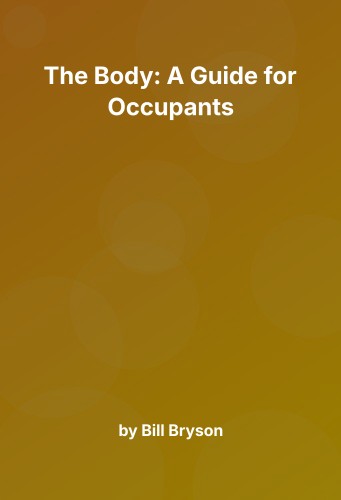Overview
The Body: A Guide for Occupants by Bill Bryson provides an engaging and informative journey through the human body, offering insights into its complex biology and anatomy. Unlike typical scientific texts, Bryson’s work is characterized by its humor and accessibility, making intricate topics understandable for the layperson. Through this exploration, Bryson aims to illuminate the marvels of the human form, similar to how Yuval Noah Harari’s Sapiens contextualizes human evolution and history, or how Atul Gawande’s Being Mortal examines healthcare and aging.
Core Frameworks and Concepts
Bryson’s book is structured around a detailed examination of the human body, where each chapter is devoted to a specific system or function. This framework not only serves to inform but also to inspire awe at the biological complexity and evolutionary ingenuity of the human organism. Here’s an expansion of Bryson’s key framework, comparing it with similar works:
Anatomy and Functionality
-
The Skeletal System: Bryson discusses the 206 bones that make up the human skeleton, highlighting their roles in movement and support. This is akin to Mary Roach’s Stiff, which provides an exploration of the body’s post-mortem journey, offering a different perspective on human anatomy.
-
The Muscular System: Muscles are essential for movement and stability. Bryson’s explanation is enriched with vivid analogies that make the concept more relatable, similar to how The Sports Gene by David Epstein delves into how genetic factors influence athletic abilities.
-
The Nervous System: The brain and nerves are central to bodily control. Bryson’s narrative here is comparable to Oliver Sacks’ The Man Who Mistook His Wife for a Hat, which explores neurological disorders to reveal the brain’s complexities.
-
The Circulatory System: Bryson examines the heart’s role in pumping blood throughout the body, akin to An Elegant Defense by Matt Richtel, which focuses on the immune system’s intricacies and its importance in maintaining health.
-
The Digestive System: The journey of food through the body is detailed with humor and clarity, providing a comprehensive look at nutrition and health, reminiscent of Michael Pollan’s In Defense of Food, which also explores dietary science.
Comparative Insights
By comparing Bryson’s exploration with other notable works, readers gain a broader understanding of the human body’s complexity and the various ways authors have approached similar themes. For instance, while Bryson uses humor and anecdotal evidence, Harari and Gawande employ historical and ethical perspectives, respectively. This multifaceted approach enriches the reader’s comprehension and appreciation of human biology.
Key Themes
1. The Complexity of the Human Body
Bryson emphasizes the intricate design of the human body, marveling at its evolutionary achievements. He describes how the body functions as an interconnected system, where each part plays a vital role in maintaining overall health. This theme resonates with the work of Harari in Sapiens, where the focus is on understanding humanity’s place in the natural world.
2. The Resilience and Fragility of Life
The human body is both robust and vulnerable. Bryson’s exploration of diseases and the body’s defense mechanisms highlights this duality, echoing themes in Richtel’s An Elegant Defense, where the immune system is portrayed as both a protector and a potential source of harm.
3. The Role of Science and Medicine
Bryson underscores the importance of scientific advancement in understanding and improving the human condition. This theme is mirrored in Gawande’s Being Mortal, which discusses the ethical considerations of medical interventions in aging and end-of-life care.
4. The Intersection of Humor and Education
Bryson’s unique style blends humor with education, making complex topics approachable. This technique is comparable to Roach’s Stiff, where humor is used to demystify and humanize the subject of death.
5. The Journey of Discovery
The book is a testament to the ongoing journey of scientific discovery, encouraging readers to remain curious and informed about their own bodies. This theme is also evident in Epstein’s The Sports Gene, which examines the interplay between genetics and athletic performance, inspiring readers to consider the science behind human potential.
Final Reflection
Bryson’s The Body: A Guide for Occupants is a comprehensive guide that not only educates but also entertains. By weaving together anecdotes, humor, and scientific facts, Bryson creates a tapestry that reveals the wonders of the human body. This synthesis of entertainment and education is crucial for engaging a broad audience and fostering a deeper appreciation for science.
In comparing Bryson’s work with those of Harari, Gawande, and others, we see a shared commitment to demystifying complex subjects for the public. Whether through historical context, ethical inquiry, or scientific exploration, these authors provide valuable insights across various domains. The cross-disciplinary nature of these works enhances their relevance, offering applications in fields such as medicine, education, and even leadership, where understanding human behavior and potential is key.
Ultimately, Bryson’s work stands out for its ability to make the reader marvel at the everyday miracle of being human. It serves as a reminder that our bodies are not merely vessels but remarkable systems capable of great resilience and adaptability. This perspective has profound implications for how we live, learn, and lead, encouraging a holistic approach to understanding the world around us.
In conclusion, The Body: A Guide for Occupants is more than just a scientific exploration; it is an invitation to appreciate the beauty and complexity of the life we inhabit. Through this lens, readers are encouraged not only to learn about their bodies but to celebrate the marvel of being alive.

